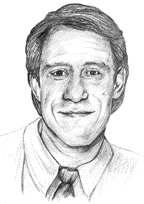 |
Maybe making money isn't the best priority to have; it could be that understanding is more valuable.
I come to this realization while reflecting on 19 years of adventuring,
trying to understand the trading markets. When I started out, my sole criterion
for success was whether a technique worked in practice -- and I never dabbled
in theory. I specifically foreswore theory in favor of practicality, but
now the two are coming closer, in that the academic and governmental worlds,
their attention focused on obvious inefficiencies in market pricing, are
making genuine headway on the nature of market dynamics.
In STOCKS & COMMODITIES,
we've featured the field of behavioral finance with the interviews of Hersh
Shefrin and Hank Pruden, but number-crunchers are beginning to put flesh
to many suppositions about market mannerisms. Avoiding eighths? See the
work of John Cooney and the van Nesses, Bonnie and Robert. Psychological
barriers? See Paul De Grauwe and Danny Decupere. Inefficient portfolio
management? Check out Philip Dybvig's take. Order flow impact? Martin Evans
and Richard Lyons. Support and resistance? Take up the subject of microstructure
(Charles Goodhard, T. Ito, and Richard Payne). Or check "clustering" work
by Lawrence Harris, Gary Gottlieb, and Avner Kalay. Technical analysis?
Andrew Lo (another S&C interview subject), Harry Mamaysky, and Jing
Wang.
You get the expanding picture. In my case,
19 years of experimentation didn't produce a fraction of the ideas all
this firepower is generating, though it must be said that precious little
of this impressive work has been turned into money-making ventures as yet.
We're entering a golden age for the study of the markets, and I doubt it
will do to simply be familiar with the relative strength index (RSI) or
stochastics.
Traders, besides surviving day to day, will need to study up on the
literature, now that there actually is literature. Some careful thinking
will be necessary to translate the valid features of market behavior discerned
by researchers into daily tactics. Some uncomfortable thinking will be
needed to discard old practices that turn out to be unfeasible in the research.
Many will want to go back to school to learn the statistical discipline
and academic rigor that the field is beginning to require. It's that or
be outclassed by more informed minds.
The industry will change too. The hot-stock touts and the quick-answer
artists will need to bone up or go away. Though the free flow of ideas
will always continue, it will be satisfying to firmly identify the bogus
and gain some firm ground for traders. I suspect that successful practice
will be confirmed, for the most part by research, since in practice bogus
work generates losses quickly.
There's a long road ahead for researchers, analysts, and traders, but
the new partnership holds great hope.
Good Fortune!